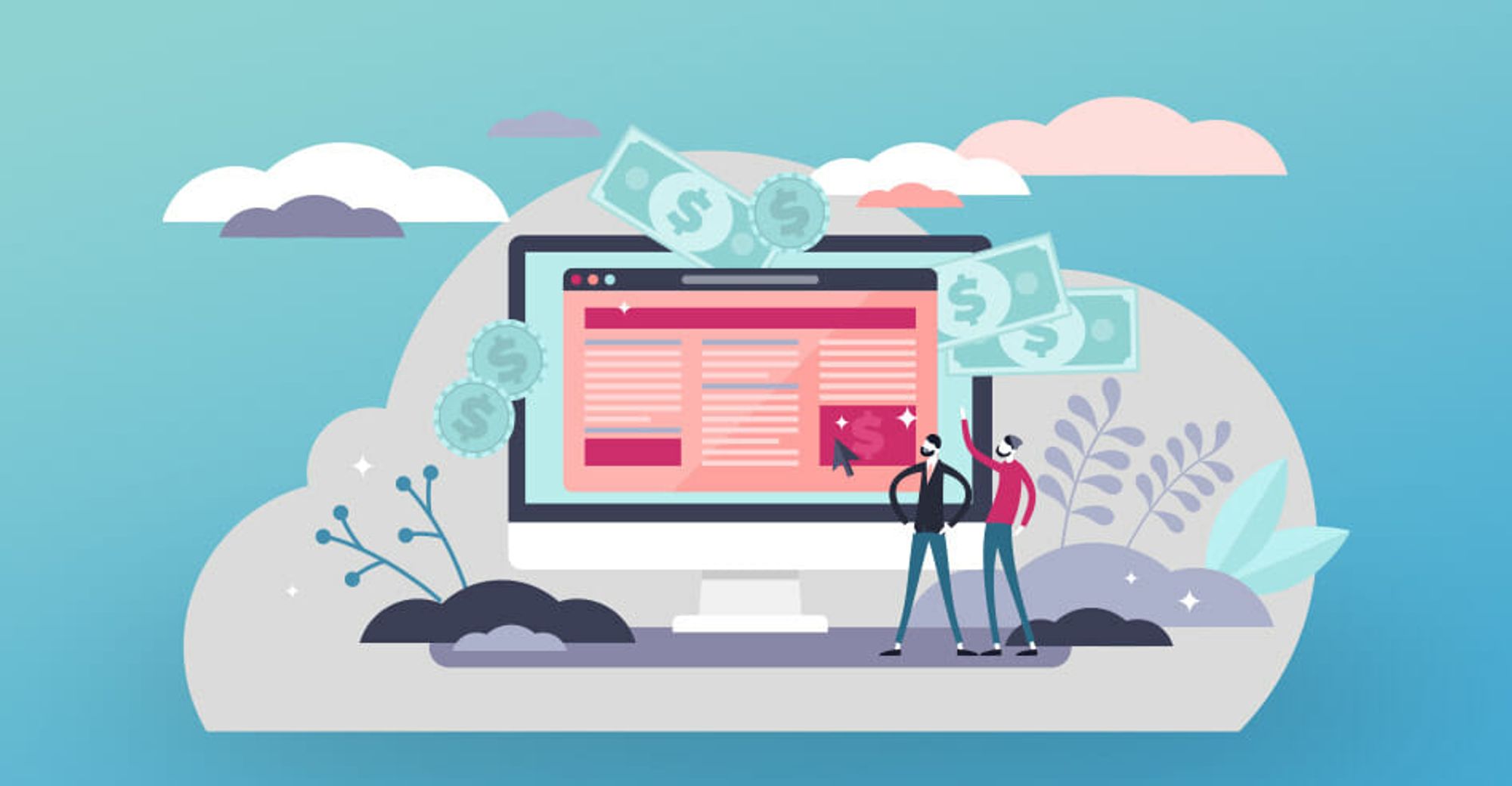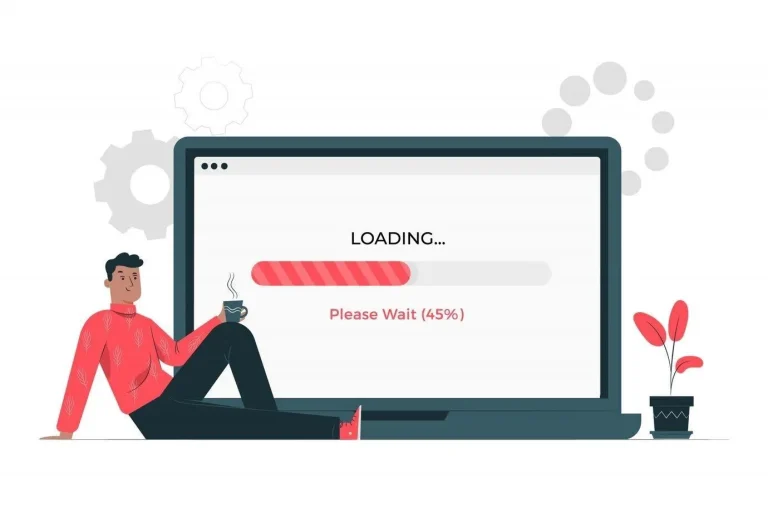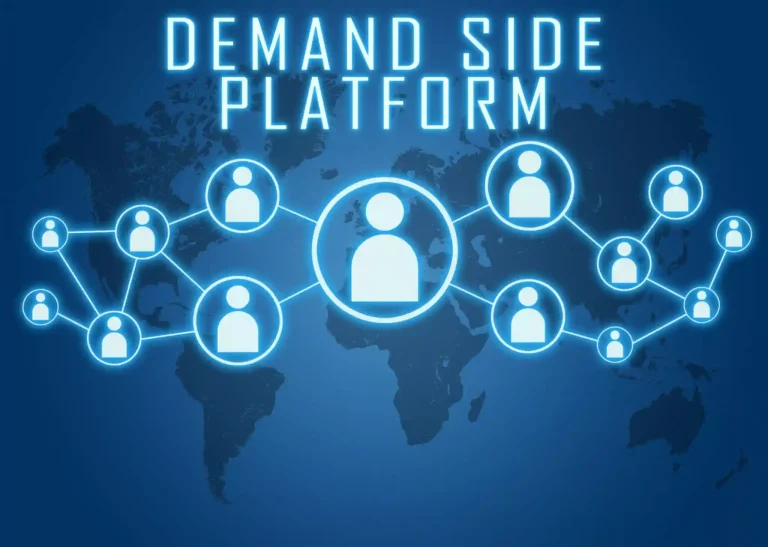From home savings schemes to big investment analyses, you have been providing users with stellar financial advice.
Now, it’s time to capitalize on it.
In this blog, you’ll find top monetization strategies for finance publishers like you to maximize revenue. So, let’s dive in:
Table of Contents
Best Monetization Strategies for Finance Publishers
Direct Deals
Advertising revenue from the internet is the most promising source for website or app visits. With valuable impressions, clicks, and conversions, publishers earn abundant revenue. Direct deal is one of the most promising parts of it.
In this method, you make a direct deal with advertisers or an intermediary to show their ads on your website for a pre-negotiated fixed CPM.
Platforms like Moneycontrol, The Washington Post, and The New York Times, among others, partner directly with advertising agencies and brands to show their ads. They create a media brochure with detailed information about their traffic, such as locations, demographics, or times of day, and sell their ad inventory at certain fixed costs to these advertisers based on the data.
This method allows you to earn maximum value out of your ad inventory without having to put in the effort of setting up auction technology to serve the ads. However, you will need an in-house sales and ad operations team to do this effectively.
How to start with it:
-
- Identify your target audience and niche: Creating your niche within the finance sector will help you attract advertisers that are a good fit for your audience.
- Develop a media kit that showcases your audience demographics and engagement metrics: This will be your sales document when pitching to potential advertisers. This kit should include information on your website traffic, audience demographics, and engagement metrics (such as time on site and bounce rate).
- Network with potential advertisers and agencies: You can join online communities to connect with potential advertisers or reach out to ad networks that specialize in finance to see if they have any direct deal opportunities.
It is a sure method of filling all your ad units while also ensuring that the ads do not disrupt the user experience. If you want to learn more about direct deals, get in touch with us today. We have some of the best guides in store for you.
However, there’s a catch—direct deals are not the perfect cut for most publishers. In fact, many big publishers struggle to get the best market value for their impressions via direct deals. And as the saying goes, “never put all your eggs in one basket.” So, let’s find out the next best things to direct deals that can help you expand your streams and generate more revenue.
Programmatic Advertising
Programmatic advertising is a wider domain under digital advertising. It refers to the automated buying and selling of ad space on the open web. You can sell your ad space to many advertisers using either an open marketplace or a private marketplace monetization strategy. The market value of programmatic is estimated to be $27 billion in 2024, becoming a go-to revenue source for millions of publishers like you.
Header bidding has been one of the most implemented programmatic advertising technologies used by global publishers to monetize their content. Almost 70% of online publishing websites in the United States use header bidding, according to Statista.
“Our experience with header bidding has been fantastic so far as it has increased our RPM substantially. Now, we can offer a more relevant and personalized ad experience to users while maximizing our potential. What we love most is the diversified demand pool and the transparency it brings to the table, allowing us to see which SSPs are bidding and their performance on each page for each ad unit.”
– Rohit Mittal, Co-founder and CEO of Stilt
Real-time selling maximizes the competition for your inventory and the ad revenue. We recommend you read our beginner’s guide on Programmatic Advertising to learn how to kickstart your programmatic journey.
How to start with it?
1. Understanding the programmatic world:
Several stakeholders are involved in programmatic advertising, including supply-side platforms (SSP), ad monetization partners, ad exchanges, and ad networks.
2. Prepare your ad inventory
Set up your ad inventory by analyzing the status of your website, like traffic, user behavior, number of ad units, and demographics.
Decide which type of ads you want to show, whether display ads, native ads, or video ads. Choose a type that suits your website and gives promising output. Here are some insights from the industry:
- Banner ads are the most popular display ads, accounting for 91% of U.S. digital advertising in 2024.
- Native ads are the most user-friendly ad type, whereas video ads are highly interactive and engaging
- Along with these types, audio ads are gaining popularity, contributing 24.6% of the market in 2023.
3. Utilize programmatic technologies
The programmatic universe is full of automation and technologies, so utilize different innovative technologies to increase your ad inventory value.
Header bidding is a prevalent technology in programmatics. It helps you connect with one or more SSPs, ad exchanges, and ad networks simultaneously (in parallel).
This will connect you with multiple advertisers in real time and increase the demand and value of your inventory.
Suggested reading: What is header bidding?
4. Connect with a programmatic partner
It is a complex task to prepare, enter, and survive in the game of programmatic advertising as it needs expertise, wisdom, and time to spend exclusively on it. If you don’t have a team to handle all this, it is better for you to connect with the best programmatic monetization partner.
Finding a good partner needs high-level scrutiny. Leave that to us. We will connect you with the best monetization partners who work from the ground to displace problems with reliable solutions to keep the revenue flowing.
5. Monitor performance, test, and iterate
Once you have onboarded a partner, it’s time to monitor the performance of your ad inventory. You can see the insights on a dashboard you are connected to, like SSPs, ad exchanges, and ad networks. If you connect with a programmatic partner, they offer a consolidated dashboard that gives a detailed view of your ad inventory performance.
This will reduce your effort in checking the ad performance in many ad platforms and consolidating it to get a whole view. Also, do continuous testing and iteration to improve your website’s ad performance and revenue.
Best practices
- User data rules the programmatic advertising. So, gather highly relevant and valuable data to attract potential advertisers.
- Aggregate first-party data or connect with data management platforms to buy data that improves your inventory value and attracts high demand.
- Try to improve ad viewability rate of your website. Advertisers now only care about the ads that are viewed rather than impressions.
Subscription
A popular monetization strategy where you ask users to pay to access your content. It gives a regular and steady income once you build a loyal user profile and have a high user retention rate.
If you don’t want to put all your content behind the paywall, you can use a premium subscription only for exclusive content materials like premium research articles, financial analysis reports, financial planning for a year, etc.
Many popular finance sites use subscriptions as their default revenue mode. Here’s how the Financial Times uses the subscription model:
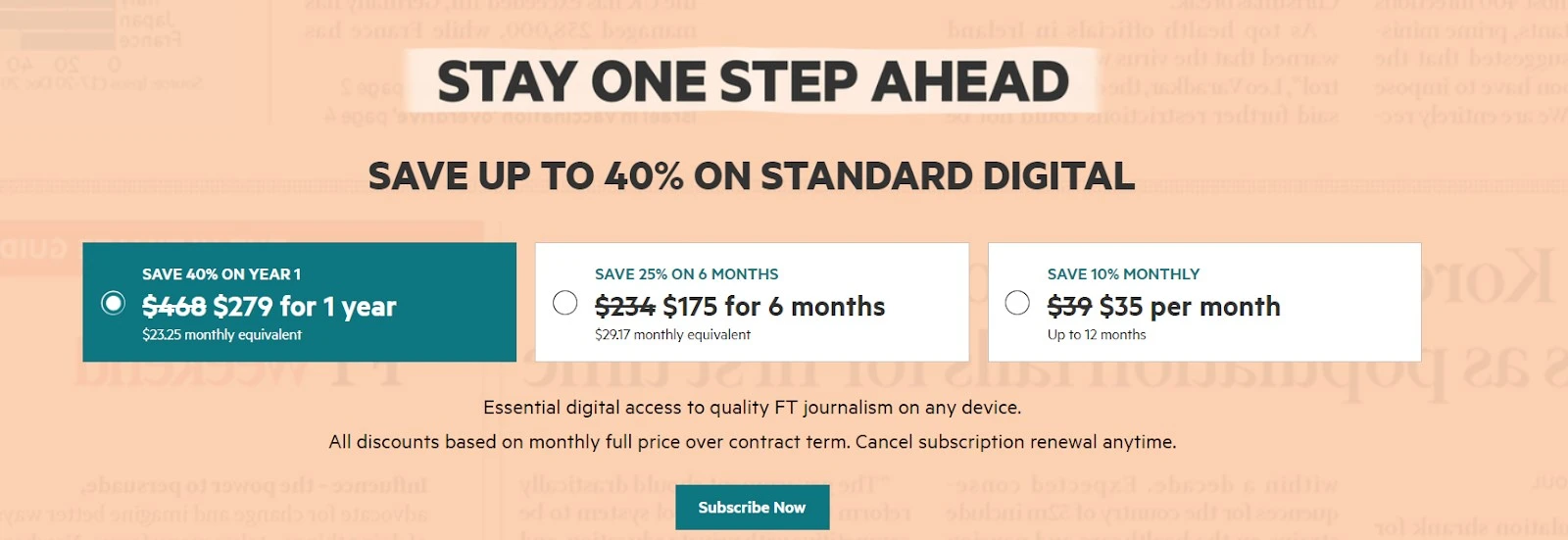
How to start with it?
- Decide a subscription offering based on your target’s online behavior, demographics, and purchasing data. The offerings can give access to exclusive content, discounts and deals, regular newsletters, consultations, and more.
- Second, choose the pricing strategy. There are many pricing models, but tiered pricing with recurrent payments (mostly monthly) is the most popular.
The tiered pricing divides the subscription into basic, premium, and enterprise. It also allows you to define plans with different benefits.
It is ideal for a site with various offerings, from content to many exclusive products. - Choose the platform or service to manage your subscription and billing.
- Keep updating your offerings per the latest trends and user interest to reduce the churn rate.
Subscription is a go-to revenue model for finance websites. Financial Times, Bloomberg, Wall Street Journal, New York Times, etc, are the best examples of using subscriptions.
The problem with the subscription model is that it is suitable only for reputed sites, not beginners.
Sell Digital Financial Products
It is one of the great ways to earn money in the finance niche, as over 2.14 billion people bought digital products in 2020, as per Statista. Digital products can be downloaded in a PDF or sheet format or accessed once the user pays for it.
Examples of digital products are:
- Financial calculators
- Investment guides
- Online community app with finance experts
- Online courses
- Stock market analysis reports
- Financial planners
- E-books
- Access to webinars and exclusive content
Out of all digital products, e-books will contribute $14.61 billion in revenue for the U.S. market in 2024, and e-learning will contribute $325 billion in 2025.
These statistics show that the demand for digital products is high now and will continue to grow in the future.
Note: Building trust and expertise is important in selling digital products. It is a long journey to convince users that you produce valuable content.
How to start with it?
The digital product should be made based on user interests and the latest financial trends. You can collect insights from the browsing behavior or ask for a vote from users on what they are looking for.
- Create products that are backed by data.
- Add an e-commerce platform or plugin to your website to list your products. You can get service from platforms like WooCommerce and Shopify.
- Promote your products on social media, communities, and forums to drive traffic to your blog.
- The best way is to add the digital products as CTA between the content on the blog pages.
This revenue source suits publishers of all scales. Here is an example of a digital product the Wall Street Journal sells.
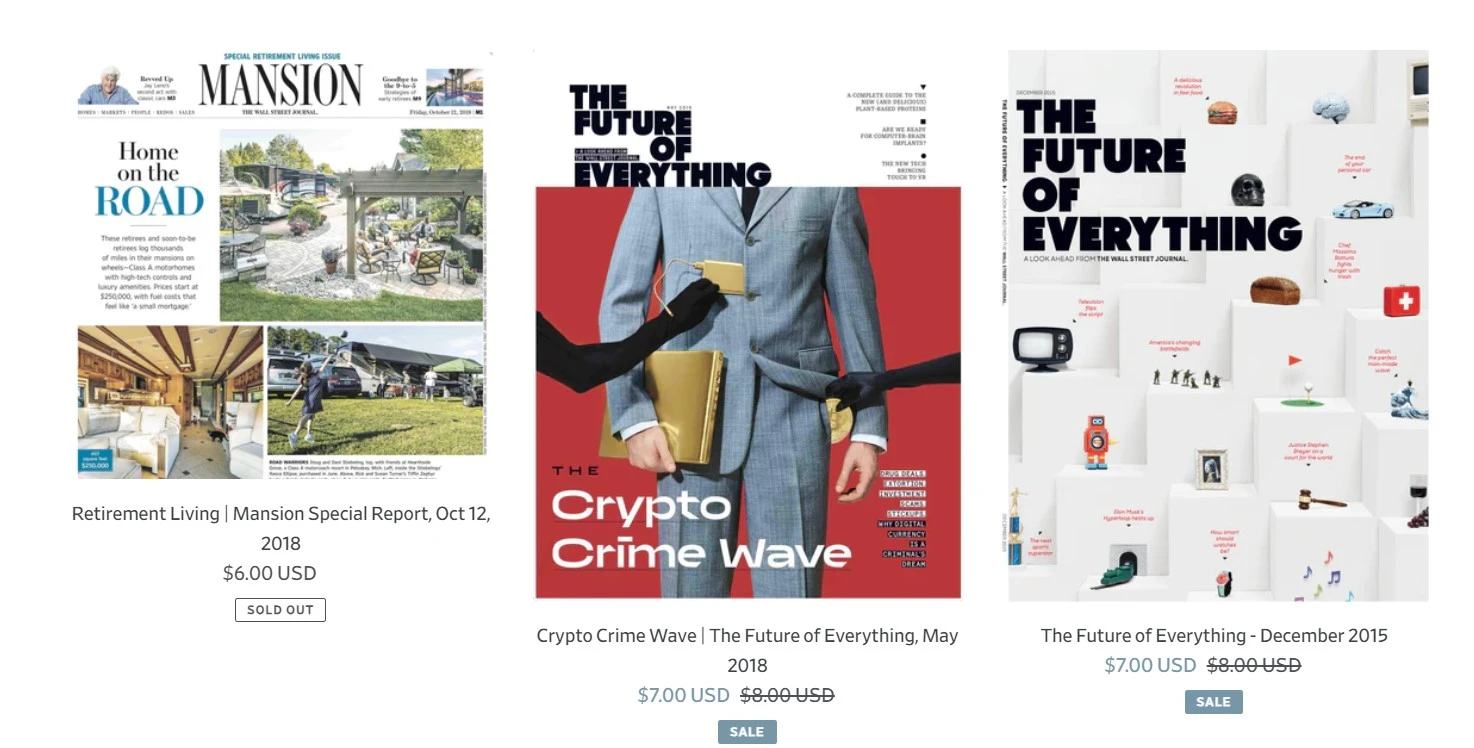
Affiliate Marketing
Affiliate marketing is the best monetization approach you can use once you have gained recurring traffic. In this method, you will get paid for inducing actions, like clicks and conversions, on the linked products and services in your blog.
You’ll have to partner with affiliate marketers and recommend different financial products and services like:
- New credit cards
- Credit card offers
- Investment program
- Online investment platforms
- Financial education courses
- Finance software
- Insurance companies
- Compare and review multiple load providers
Advertisers will pay you the promised money if the user interacts with your links and/or if that ends in actions like adding to a cart or purchasing.
You can add links to images, product titles, and CTA buttons whenever you mention the product.
While there may be multiple finance affiliate products, you should only choose products that suit your audience’s interest to get high conversions.
How to start with it?
- Find an affiliate program that works for you.
- Check whether you are eligible to enter the program or if they are reliable enough to choose for affiliate.
- Sign up with them and start referring.
- Disclose your links with the disclaimer that it is an affiliate link like below.
Note: Affiliate marketing suits all publishers: small, medium, and enterprise. An enterprise publisher might be qualified to promote popular brands, while small and medium publishers will get a chance to promote less popular but good brands. The terms and conditions of the products and services depend mostly on affiliation. Relevancy and target also play a vital role in this.
What to Pick?
Crossing choices to pick one of the top optimal monetization strategies is always a challenging journey.
Go for a subscription model only if you are popular among your target audience and provide them with value that others can’t. Affiliate marketing is a go-to solution for any publisher, so it is a must-try. You can throw affiliate marketing in a mix with any other option as well.
The research by Digiday suggests that most publishers will focus on direct deals in 2024 and have less interest in subscriptions – as it can provide maximum reach, whereas subscription limits you.
If not direct deals, the next best option would be investing in programmatic advertising. It remains the top revenue stream for publishers as it has an increased adoption rate with a $595 billion global ad spend, and the U.S. has the largest market share.
While every stream is on the rise, utilizing a combination of monetization strategies would be ideal if you are an early-stage publisher. We would recommend utilizing more than one monetization strategy like direct deals and programmatic while also focusing on selling digital products or using affiliate marketing. The reason is no one monetization strategy would make money for you in all quarters of the year.


